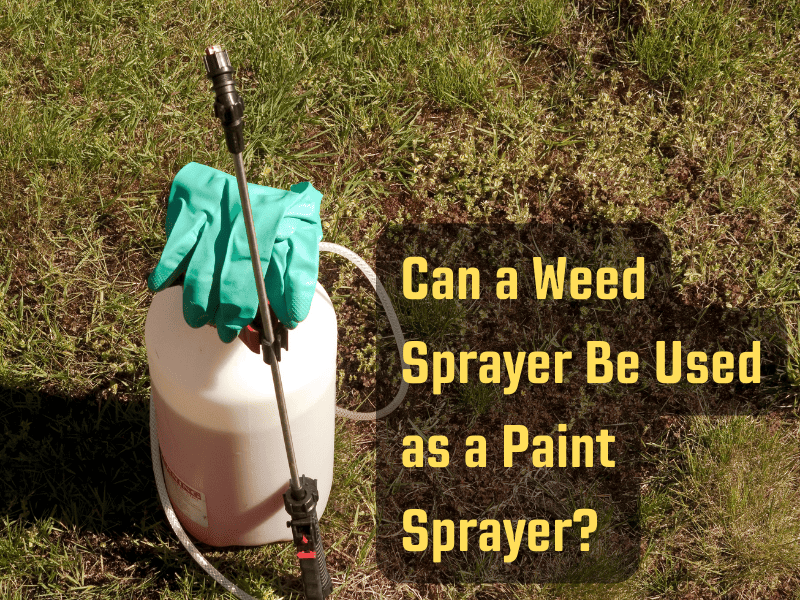There’s a question that often arises amongst the DIY crowd, those looking to be a bit more crafty or resourceful in their projects: Can you use a weed sprayer as a paint sprayer? It’s a legitimate query, given their apparent resemblance and similar operational systems. This article delves into the core of this question, dissecting the crucial differences, requirements, and functionalities of these two seemingly similar tools.
Table of Contents
Weed Sprayers vs. Paint Sprayers: Understanding the Basics
At the most basic level, weed sprayers and paint sprayers are designed to accomplish different tasks. Weed sprayers, as their name implies, are specifically made to spray herbicides or pesticides across gardens, fields, or green spaces. On the other hand, paint sprayers are designed to apply paint on different surfaces.
The contrast doesn’t stop at their primary functions. These tools specific designs and construction are uniquely optimized for their intended use. Paint sprayers have nozzles and pump systems constructed to handle the thickness and consistency of paint, thus ensuring a smooth and even application. In contrast, weed sprayers are crafted to manage and distribute less viscous liquids, like water-based pesticides or herbicides.
The Reality Check: Potential Limitations and Challenges
Should you decide to repurpose a weed sprayer as a paint sprayer, you’d soon run into a few inevitable obstacles. One primary concern would be the viscosity of the paint. By its very nature, paint is considerably thicker than the liquids typically used in a weed sprayer. This difference in thickness means a weed sprayer may struggle to effectively pick up and spray paint, possibly leading to an uneven application or even a complete blockage in the sprayer mechanism.
Moreover, a weed sprayer’s spray pattern and control may not be as sophisticated or adjustable as a paint sprayer’s. This becomes a significant limitation when painting, as the ability to vary the spray pattern – from a broad spray for covering large surfaces to a narrow, concentrated spray for detailed work – is critical for a successful paint job. This level of versatility is generally not available in a typical weed sprayer.
A DIY Endeavor: Using a Weed Sprayer for Painting
With these potential limitations and challenges in mind, experimentation might be your way forward if you’re still considering using a weed sprayer as a paint sprayer. Here are some practical steps to help mitigate the challenges:
- Thinning the Paint: Dilute your paint to a consistency that the weed sprayer can manage. Remember, this might mean you’ll need to apply several coats of paint for adequate coverage.
- Thorough Cleaning: Ensure your weed sprayer is clean and free of any chemical residue that might interfere with the paint.
- Testing Phase: Before diving into your project, test the sprayer on scrap material. This preliminary step will allow you to see how the sprayer handles the paint and gauge the number of coats you might need.
- Patience is Key: Take it slow. Remember, you’re using the weed sprayer for a purpose it wasn’t designed for. Pushing it too hard or fast might result in poor results or damage to the tool.
Why It Might Not Work
While the steps mentioned above may seem encouraging, it’s important to note that most professionals and experienced DIY enthusiasts would advise against using a weed sprayer as a paint sprayer. Despite their superficial similarities, these two tools have been designed with specific purposes in mind. Hence, they have unique features optimized for their respective tasks.
With its specialized design, a paint sprayer is your best choice for painting tasks. It ensures a smooth, controlled, and precise application of paint, thus guaranteeing an excellent finish. In contrast, using a weed sprayer for paint application could be likened to using a screwdriver to hammer a nail; it might work to some extent, but it won’t be as efficient or effective as using the right tool for the job.
Going Beyond the Surface: The Nitty-Gritty of Paint Spraying
If you’re still debating whether or not to try using a weed sprayer for painting, consider this: A professional-grade sprayer has many features that go far beyond simply spraying paint.
Paint sprayers often come with multiple tip options, allowing for various spray patterns and droplet sizes. This means that you can choose the best option for the job at hand, whether that’s painting a large wall or adding intricate details to a piece of furniture.
Furthermore, most paint sprayers come with pressure control options. This feature lets you control the speed and volume of the paint being sprayed, enabling you to get the perfect finish, whether working with thin, delicate materials or needing to cover a large, rough surface quickly.
Paint sprayers are also designed to handle a wide range of paint types, from thin stains to thick latex paints. This versatility makes them a worthwhile investment for any serious DIY enthusiast or professional painter.
Conclusion
While it might be technically feasible to use a weed sprayer as a paint sprayer, it’s far from the best tool for the job. The limitations and challenges you face and the notable differences in design and function between the two tools make it a less-than-optimal solution.
Resourcefulness is a crucial trait in DIY endeavors, but it’s equally important to remember the benefits of using the right tool for the job. In the long run, investing in a paint sprayer specifically designed for your painting needs can save you time, effort, and even money, while ensuring a high-quality finish. So, when it comes to painting, it might be best to stick with the tried-and-true: a dedicated paint sprayer.
